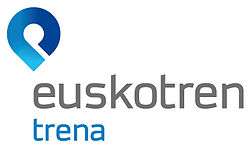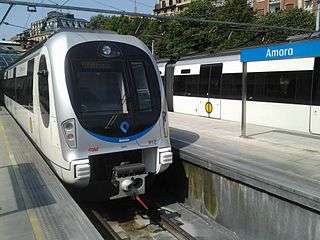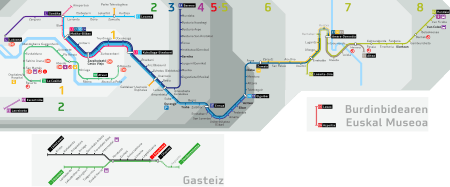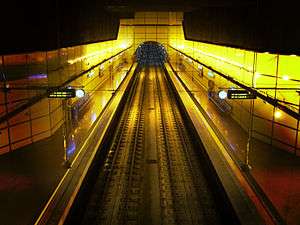Euskotren Trena
Euskotren Trena, formerly known just as Euskotren is a commuter, inter-city and urban transit train-operating company that operates local and inter-city passenger services in the provinces of Biscay and Gipuzkoa, in the Basque Country, Spain. It is one of the four commercial brands under which Basque Railways operates, as a public company managed by the Basque government. The entire 181.1-kilometre (112.5 mi) network[2] uses 1,000 mm (3 ft 3 3⁄8 in) narrow gauge rail tracks which have been owned by the Basque Government since their transferral from the Spanish government; the rail tracks and stations were part of the FEVE network until its transferral. Euskotren Trena also operates the Donostia/San Sebastián metro under the brand Metro Donostialdea.
 | |
 | |
| Overview | |
|---|---|
| Owner | Eusko Trenbideak |
| Locale | Biscay, Gipuzkoa (Basque Country) |
| Transit type | Commuter rail Inter-city rail |
| Number of lines | 8 |
| Number of stations | 79 |
| Annual ridership | 39.5 million (2018)[1] |
| Headquarters | 8 Atxuri Street, Bilbao, Biscay |
| Website | Eskotren Trena |
| Operation | |
| Began operation | 1982 |
| Operator(s) | Eusko Trenbideak |
| Technical | |
| System length | 181.1 km (112.5 mi)[2] |
| Track gauge | 1,000 mm (3 ft 3 3⁄8 in) |
| Electrification | ? |
Euskotren Trena operates the railway services and networks, while Euskotren Tranbia operates the tram networks, Euskotren Autobusa the bus services and Euskotren Kargo the freight rail services. Since 2006 Euskotren Trena has been the commercial brand for the operator of the railway network in the Basque Country, which is Eusko Trenbideak, while the network itself is owned by the public entity Euskal Trenbide Sarea. In 2012 the commercial brand was changed from simply Euskotren to Euskotren Trena, adding the Basque word trena.
Services
Introduction
Euskotren Trena operates the railway network owned by Euskal Trenbide Sarea (Basque Railway Network) in the Basque provinces of Biscay and Gipuzkoa, as well as a short track and a station in the Pyrénées-Atlantiques department of France. The initial network was a continuation of the FEVE (narrow gauge railways) regional services and FTS (Bilbao's metropolitan railways and transportation) urban services. The services have since then improved to become a commuter rail system along with Inter-city rail services. The network connects the city of Bilbao with municipalities across the Greater Bilbao area and the province of Biscay, such as Durango, Bermeo and Lezama. In the province of Gipuzkoa it connects the city of Donostia-San Sebastián with other cities and towns such as Zarautz, Lasarte-Oria, Irun and Hendaye, the latter in France. The Inter-city rail services connect the cities of Bilbao and San Sebastián with each other and with Hendaye. Since August 2012, Euskotren Trena has operated the Donostia/San Sebastián metro system, based on the Topo network, under the brand Metro Donostialdea.[3]
Euskotren Trena is operated by Eusko Trenbideak.
Lines

The Euskotren Trena network consists of the following lines:
- Biscay-Gipuzkoa

- Bilbao, Biscay






- Donostia, Gipuzkoa





The network connects to the Euskotren Tranbia line, Metro Bilbao, FEVE, RENFE and Cercanías services. The Euskotren trena lines do not appear with other train lines in standard printed network maps, but separate maps are available. The Euskotren Trena lines appear together with other railway networks of the Basque Country in the Moveuskadi.com service provided by the Basque Government.
Former or closed lines
- Sections of the Txorierri line. The railway service on the Txorierri line between Casco Viejo and Deusto was suspended in May 2010 for a period of three years, because of the construction of Line 3 of Metro Bilbao. The closed stations are Deusto, Unibertsitatea, Matiko and Zumalakarregi. The Loruri-Ciudad Jardín station, formerly closed, was open to provide a service to the users of the now closed stations.
- Urola line. The Urola line, formerly served by the Urola Railway, was closed by Eusko Trenbideak in 1986, after a futile attempt to renovate it. The service was replaced by a bus line between the municipalities of Zumaia and Zumarraga.
- Bilbao-Plentzia line. Bilbao-Plentzia was the line with the most users at the time of its closure. The original line connected downtown Bilbao, starting at Casco Viejo Station with the town of Plentzia, at Plentzia Station. During the construction of the Line 1 of Metro Bilbao, it was decided that the section between San Inazio and Plentzia would be managed by Metro Bilbao, as part of line 1, instead of Euskotren. The Casco Viejo Station was then connected to the Txorierri line, and the Ciudad Jardín and Mallona stations were closed (due their proximity to the station in Casco Viejo). The Deusto-San Inazio section was eventually closed due the construction of a new highway where the railway tracks were located.
- Lutxana-Sondika line. The line between Sondika and Lutxana (in Erandio), both in the Greater Bilbao area was closed in 1996 after an attempt to re-open it for passenger services. However, the tracks are still in use; Euskotren Trena uses it for testing new units.
Service frequencies

As of January 2014, typical services frequencies for weekdays are:[5]
- Bilbao-Donostia line – one train per hour between Bilbao-Atxuri and Donostia-Amara.
- Durangaldea line – two trains per hour between Bilbao-Atxuri and Ermua in each direction, with one continuing to Donostia-Amara, and some express trains between Bilbao and Durango, Traña and Zaldibar.
- Kostaldea line – one train per hour between Ermua and Donostia-Amara in each direction (the ones starting at Donostia-Amara continuing to Bilbao-Atxuri).
- Tranbia Ermua-Eibar line – four trains per hour between Ermua and Eibar in each direction.
- Topo line – four trains per hour between Lasarte-Oria and Irun, with two continuing to Hendaye. Two trains per hour between Hendaye and Lasarte-Oria.
- Urdaibai line – two trains per hour between Bilbao-Atxuri and Bermeo in each direction and four express trains per day between Bilbao and Gernika.
- Txorierri line – two trains per hour between Casco Viejo and Lezama in each direction. Three trains per hour during peak times.
- Larreineta funicular – one funicular per hour between Larreineta and Escontrilla. Two per hour during peak times.
Stations
The Euskotren Trena network serves the following stations (the Bilbao-Donostia line stations are included in the sections of Durangaldea and Kostaldea):
| Durangaldea line | Kostaldea line | Tranbia line | Metro Donostialdea line | Urdaibai line |
|---|---|---|---|---|
|
|
|
|
|
| Txorierri line |
|---|
|
Current operations
Eusko Trenbideak, which operates the Euskotren Trena brand has its central offices in the Bilbao-Atxuri Station, in the district of Ibaiondo, in Bilbao. There are operations centres in several stations, including those of Durango and Donostia-San Sebastián. Currently, the rolling stock is maintained at depots in Abadiño, Gernika and Errenteria. New depots are being built in Irun.
Ticketing
Euskotren Trena uses both regular paper tickets and the Barik card available only on some lines. Users can acquire single tickets and return tickets at the vending machines available at every station, and monthly and yearly travel cards are also available. Young people and elderly people also may acquire special tickets.[6] The Barik travel ticket was initially only available on the Txorierri line, and it will be available for use on all lines once it is fully implemented.
The ticket pricing is based on zone-based rules.
Rolling stock
Euskotren Trena uses several trains from four different series, named UT200, UT300, UT3500 and the newest UT900, all produced by CAF. As the whole network is electrified, all the units are electric. The oldest are the trains from the UT3500 series, which started operations in the 1970s as a replacement for the very old and rather dilapidated trains of the Ferrocarriles Vascongados. The UT900 series use state-of-the-art technology and started operations in 2011.
Current fleet
| Class | Image | Type | Top speed (km/h) | Cars per set | Routes operated | Built | Notes |
|---|---|---|---|---|---|---|---|
| EMU 900 | Electric multiple unit | 90 | 4 | Metro Donostialdea Durangaldea line |
2011–present | New units started operating in Topo's line. Set to replace UT3500. At the moment there are 26 units that operate in all the lines | |
| EMU 950 | Electric Multiple Unit | 90 | 3 | Txorierri Urdaibai Line 3 of Bilbao metro |
2016-2018 | New units started operating in Txorierri line. Now, their ar running in Urdaibai line, in the tram between Eibar and Ermua and in the third line of Metro Bilbao between Matiko and Kukullaga. | |
| UT-300 |  |
Electric multiple unit | 90 | 2 | Txorierri line Bilbao-Donostia inter-city line (express service) |
1990 | Operate in Txorierri's line, red-coloured units in Bilbao-Donostia's line. |
| UT-200 |  |
Electric multiple unit | 80 | 4 | Bilbao-Donostia inter-city line Topo line Urdaibai line Kostaldea line |
1985 | Operate in Durangaldea's line, Kostaldea's line, Urdaibai's line and The Tram between Eibar and Ermua |
Previous fleet
| Class | Image | Type | Top speed (km/h) | Cars per set | Routes operated | Built | Notes |
|---|---|---|---|---|---|---|---|
| UT-3100 | Electric multiple unit | 75 | 3 | Bilbao-Donostia line | 1988 | ||
| UT-3150 | Electric multiple unit | 70 | 1 | Tranbia Ermua-Eibar | 1989–1990 | Transformation of the MCD series. | |
| UT-3500 |  |
Electric multiple unit | 80 | 3 | Durangaldea line Tranbia Ermua-Eibar Urdaibai line |
1977 | Replaced by the UT900 series, their last service was on 6 July 2013. |
Livery

The new rolling stock (UT-900) is painted with the new Euskotren Trena livery, white with black contrast and blue and orange circles in the doors. Older rolling stock maintains the blue and white colours, common in Euskotren from 2002.
Current developments
The developments of the network operated by Eusko Trenbideak, under the commercial brand of Euskotren Trena, are being conducted by Euskal Trenbide Sarea, which has control of the Basque railway network. The developments do not include any expansion of the lines or new lines (those not yet proposed or planned) but the improvements of the current network, with new stations, alternate routes and a second rail track in areas where there is only one, as well as the elimination, or at least reduction, of all the level crossings.
- Euba-Iurreta section. The section between Euba, in Amorebieta-Etxano and Iurreta is currently being upgraded to include a second track, in order to improve frequencies and eliminate ten level crossings. This development is part of the Durango+ project, which aims to improve the service and frequencies in the Durangaldea region. It was scheduled to be finished in 2013.[7]
- Iurreta-Durango-Abadiño section. The section immediately after Euba-Iurreta is the Iurreta-Durango-Abadiño section, which is being constructed underground, in order to eliminate the level crossings and tracks that go through Durango and Abadiño. Two new stations will emanate from this project: an underground station for Durango to replace the current overground one and the Fauste Landako station and a semi-underground station for the neighbourhood of Matiena, in Abadiño (also replacing the current one). The Durango depot will be moved to new facilities in Lebario, Abadiño. It was expected to be finished in 2013.[8]
- Abadiño-Berriz section. The section between Abadiño and Berriz is being renewed in order to add a second rail track. This section includes the new depot and offices at Lebario, and a new train station in Berriz.
- Eibar-Elgoibar section. The section between Eibar and Elgoibar is being completely renewed with:
- A new station in Eibar, at a cost of €200,000 which replaces the whole station with the addition of lifts, removal of level crossings and the incorporation of new platforms.[9]
- Txarakua-Azitain section. The incorporation of a second rail track to improve frequency of trains. It was scheduled to be opened in late 2012.[10]
See also
- Bilbao rail network
- Eusko Trenbideak - Ferrocarriles Vascos
References
- "El Topo gana en Gipuzkoa un 11,6% de viajeros". El Diario Vasco (in Spanish). 19 January 2019. Retrieved 5 September 2019.
- "Inicio – Corporativo – Información Corporativa – Euskotren Trena – Trenes" [Home – Corporate – Corporate Information – Euskotren Trena – Trains] (in Spanish). Eskotren Trena. Archived from the original on 19 May 2014. Retrieved 18 May 2014.
- http://www.diariovasco.com/v/20121004/al-dia-local/metro-conecta-desde-intxaurrondo-20121004.html
- Official Schedules at Euskotren Trena website
- Schedules at Euskotren Trena's Official Website
- Tickets at Euskotren Trena official website]
- El Correo (ed.). "El desdoblamiento de la vía férrea hasta Abadiño enfilara en otoño su recta final".
- El Correo (ed.). "Arriola vuelve a retrasar las obras del soterramiento a mediados de 2013".
- El Diario Vasco (ed.). "Avanza la remodelación de la antigua estación de EuskoTren".
- El Correo (ed.). "El tramo ferroviario entre Txarakua y Azitain tendrá doble vía para mediados del 2012".
External links
| Wikimedia Commons has media related to Euskotren Trena. |